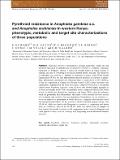| dc.contributor.author | Silas Agumba, John E Gimnig, Lilian Ogonda, Maurice Ombok, Jackline Kosgei, Stephen Munga, Benard Guyah, Seline Omondi, Eric Ochomo | |
| dc.date.accessioned | 2022-01-23T08:32:50Z | |
| dc.date.available | 2022-01-23T08:32:50Z | |
| dc.date.issued | 2019 | |
| dc.identifier.uri | https://repository.maseno.ac.ke/handle/123456789/4556 | |
| dc.description.abstract | Background: Malaria vector control is dependent on chemical insecticides applied to walls by indoor residual spraying or on long-lasting insecticidal nets. The emergence and spread of insecticide resistance in major malaria vectors
may compromise malaria control and elimination eforts. The aim of this study was to estimate a diagnostic dose
for chlorfenapyr (class: pyrrole) and clothianidin (class: neonicotinoid) and assess the baseline susceptibility of three
major Anopheles malaria vectors of western Kenya to these two insecticides.
Methods: The Centers for Disease Control and Prevention (CDC) bottle assay was used to determine the diagnostic
doses of chlorfenapyr and clothianidin insecticides against the susceptible Kisumu strain of Anopheles gambiae. Probit
analysis was used to determine the lethal doses at which 50% (LD50) and 99% (LD99) of the susceptible mosquitoes
would be killed 24, 48 and 72 h following exposure for 1 h. Insecticidal efcacy of chlorfenapyr, clothianidin and the
pyrethroid deltamethrin was then evaluated against feld collected female Anopheles mosquitoes sampled from
Nyando, Bumula and Ndhiwa sub-Counties in western Kenya. Members of Anopheles funestus and An. gambiae complexes were identifed using polymerase chain reaction (PCR).
Results: The determined diagnostic doses of chlorfenapyr and clothianidin insecticides were 50 µg/bottle and
150 µg/bottle, respectively, for An. gambiae, Kisumu strain. When exposed to the diagnostic dose of each insecticide,
Anopheles malaria vector populations in western Kenya were susceptible to both insecticides with 100% mortality
observed after 72 h. Mortality of mosquitoes exposed to deltamethrin increased over time but did not reach 100%.
Mortality of Anopheles arabiensis from Nyando exposed to deltamethrin was 83% at 24 h, 88% at 48 h and 94.5% at
72 h while An. funestus from Ndhiwa was 89% at 24 h, 91.5% at 48 h and 94.5% at 72 h.
Conclusion: Mosquitoes of western Kenya, despite being resistant to pyrethroids, are susceptible to chlorfenapyr
and clothianidin. Field evaluations of the formulated product are needed | en_US |
| dc.publisher | BioMed Central | en_US |
| dc.subject | Anopheles, Anopheles gambiae sensu stricto, Anopheles arabiensis, Anopheles funestus, Chlorfenapyr, Clothianidin, Insecticide resistance | en_US |
| dc.title | Diagnostic dose determination and efficacy of chlorfenapyr and clothianidin insecticides against Anopheles malaria vector populations of western Kenya | en_US |
| dc.type | Article | en_US |

